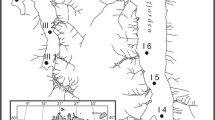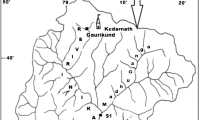Abstract
Diatom floras from springs have received little attention until recently, despite the fact that springs provide specific conditions that cannot be found in any other aquatic system, and remain of great importance in terms of general environmental changes. Due to pollution of the Kraków-Częstochowska upland aquifers, the chemical composition of spring waters in the area is anthropogenically modified, and far from the natural state. In order to generate a baseline diatom flora for springs, a paleolimnological study was applied as one of the best recognized and applied methods used to track long-term environmental changes worldwide. Little is known, however, about the direction and nature of such changes in aquatic environments fed by springs. The present article focuses on shifts in diatom assemblages preserved in sediments collected from a small pond, situated close to several spring outlets. They were interpreted as a record of environmental changes that had taken place during the last century. For most of the history of the pond—as recorded in this 84 cm long core—the diatom assemblage was dominated by small Fragilaria spp. The major shifts in species composition began in a core depth of 65 cm with a decline in Fragilaria construens var. venter (Ehrenberg) Grunow and Fragilaria pinnata Ehrenberg complexes, and a concurrent increase in Achnanthidium minutissimum (Kützing) Czarnecki. The second change was recorded at the depth of 45 cm with a sharp decline of A. minutissimum, which again was replaced by the small Fragilaria spp. In recent years, further changes in the diatom assemblage occurred, with a notable increase in Cyclotella delicatula Hustedt. The assemblage shifts recorded at this site appear to be consistent with environmental changes triggered by land use (e.g. agriculture intensity) and/or possible changes in spring water discharge.


Similar content being viewed by others
References
Baścik, M., W. Chełmicki, A. Korska, J. Pociask-Karteczka & J. Siwek, 2001. Źródła Wyżyny Krakowsko-Wieluńskiej i Miechowskiej. Zmiany w latach 1973–2000. Springs of the Kraków-Wieluń and Miechów Uplands. Changes between 1973 and 2000 (in Polish). Uniwersytet Jagielloński, Instytut Geografii i Gospodarki przestrzennej, Zakład Hydrologii, Kraków: 1–127.
Battarbee, R. W., 1986. Diatom analysis. In Berglund, B. E. (ed.), Handbook of Holocene Palaeoecology and Palaeohydrology. John Wiley & Sons, Chichester, New York, Brisbane, Toronto, Singapore: 527–570.
Battegazzore, M., A. Morisi, B. Gallino & S. Fenoglio, 2004. Environmental quality evaluation of alpine springs in NW Italy using benthic diatoms. Diatom Research 19: 149–165.
Bennion, H., P. Appleby & G. L. Phillips, 2001. Reconstructing nutrient histories in the Norfolk Broads, UK: implications for the role of diatom-total phosphorus transfer functions in shallow lake management. Journal of Paleolimnology 26: 181–204.
Cantonati, M., 1998. Diatom communities of springs in the Southern Alps. Diatom Research 13: 201–220.
Cantonati, M., 2001. The diatom communities of the liverwort Chiloscyphus polyanthus var. rivularis in a mountain spring-fed stream in the Adamello-Brenta Regional Park, Northern Italy. In Jahn, R., J. P., Kociolek, A. Witkowski & P. Compère (eds), Lange-Bertalot-Festschrift. Studies on Diatoms. A.R.G. Gantner Verlag K.G., Ruggell: 353–368.
Cantonati, M., R. Gerecke & E. Bertuzzi, 2006. Springs of the Alps—sensitive ecosystems to environmental change: from biodiversity assessments to long-term studies. Hydrobiologia 562: 59–96.
Dodds, W. K., 2003. The role of periphyton in phosphorus retention in shallow freshwater aquatic systems. Journal of Phycology 39: 840–849.
Dojlido, J. R., 1987. Chemia wody. Water chemistry (in Polish). Arkady, Warszawa: 136–145.
Filippi, M. L., 2007. Paleo-ecological studies on springs: strategic approach and methods. In Cantonati, M., E. Bertuzzi & D. Spitale (eds), The Spring Habitat: Biota and Sampling Methods. Museo Tridentino di Science Naturali, Trento: 299–306.
Filippi, M. L., N. Angeli, L. Marziali, A. H. I. Matouk, E. Bertuzzi, V. Lencioni & M. Cantonati, 2008. Paleolimnological techniques applied to springs habitats: challenges and limits as highlighted by the CRENODAT project (southeastern Alps, Italy). Verhandlungen der Internationalen Vereinigung für Limnology 30: 329–332.
Kadłubowska, J. Z., 1985. Untersuchungen der Stetigkeit der Diatomeengesellschaften aus der Saltzquelle, den Limnokrenen und dem Moortümpel. Verhandlungen der Internationalen Vereinigung für Limnology 22: 2834–3837.
Keatley, B. E., M. S. V. Douglas & J. P. Smol, 2006. Early-20th century environmental changes inferred using subfossil diatoms from a small pond on Melville Island, N.W.T., Canadian high Arctic. Hydrobiologia 553: 15–26.
Krammer, K., 1997a. Die cymbelloiden Diatomeen. Eine Monographie der weltweit bekannten Taxa. Teil 1. Allgemeines und Encyonema Part. Bibliotheca Diatomologica 36. J. Cramer, Berlin, Stuttgart.
Krammer, K., 1997b. Die cymbelloiden Diatomeen. Eine Monographie der weltweit bekannten Taxa. Teil 2. Encyonema part., Encyonopsis and Cymbellopsis. Bibliotheca Diatomologica 37. J. Cramer, Berlin, Stuttgart.
Krammer, K., 2000. The genus Pinnularia. In Lange-Bertalot, H. (ed.), Diatoms of Europe. 1. A.R.G. Gantner Verlag K.G., Vaduz.
Krammer, K., 2002. Cymbella. In Lange-Bertalot, H. (ed.), Diatoms of Europe. 3. A.R.G. Gantner Verlag K.G., Ruggell.
Krammer, K., 2003. Cymbopleura, Delicata, Navicymbula, Gomphocymbellopsis, Afrocymbella. In Lange-Bertalot, H. (ed.), Diatoms of Europe. 4. A.R.G. Gantner Verlag K.G., Ruggell.
Krammer, K. & H. Lange-Bertalot, 1986. Bacillariophyceae. 1. Naviculaceae. In Ettl, H., J. Gerloff, H. Heyning & D. Mollenhauer (eds), Süβwasserflora von Mitteleuropa 2. G. Fischer Verlag, Stuttgart, New York.
Krammer, K. & H. Lange-Bertalot, 1988. Bacillariophyceae. 2. Bacillariaceae, Epithemiaceae, Surirellaceae. In Ettl, H., J. Gerloff, H. Heyning & D. Mollenhauer (eds), Süβwasserflora von Mitteleuropa 2. G. Fischer Verlag, Stuttgart, NewYork.
Krammer, K. & H. Lange-Bertalot, 1991a. Bacillariophyceae 3. Centrales, Fragilariaceae, Eunotiacae. In Ettl, H., J. Gerloff, H. Heyning & D. Mollenhauer (eds), Süβwasserflora von Mitteleuropa. 2. Gustaw Fischer Verlag, Stuttgart, Jena.
Krammer, K. & H. Lange-Bertalot, 1991b. Bacillariophyceae. 4. Achnanthaceae, Kritische Ergänzungen zu Navicula (Lineolatae) und Gomphonema, Gesamtliteraturverzeichnis. In Ettl, H., G. Gärtner, J. Gerloff, H. Heyning & D. Mollenhauer (eds), Süβwasserflora von Mitteleuropa. 2. G. Fischer Verlag, Stuttgart, Jena.
Lange-Bertalot, H., 1993. 85 new taxa and much more than 100 taxonomic clarifications supplementary to Süβwasserflora von Mitteleuropa 2(1–4). Bibliotheca Diatomologica 27. J. Cramer, Berlin, Stuttgart.
Lange-Bertalot, H., 2001. Diatoms of the European inland waters and comparable habitats. Navicula sensu stricto, 10 genera separated from Navicula sensu lato, Frustulia. In Lange-Bertalot, H. (ed.), Diatoms of Europe. 2. A.R.G. Gantner Verlag K.G., Vaduz.
Lange-Bertalot, H. & D. Metzeltin, 1996. Oligotrophie-Indikatoren. 800 Taxa in drei ökologisch diversen Seen-Typen. In Lange-Bertalot, H. (ed.), Iconographia Diatomologica. Annotated Diatom Micrographs 2, Ecology-Diversity-Taxonomy. Koeltz Scientific Books, Koenigstein.
Lange-Bertalot, H., P. Cavacini, N. Tagliaventi & S. Alfinito, 2003. Diatoms of Sardinia. Rare and 76 new species in rock pools and other ephemeral waters. In Lange-Bertalot, H. (ed.), Iconographia Diatomologica. Annotated Diatom Micrographs 12, Biogeography-Ecology-Taxonomy. A.R.G. Gantner Verlag K.G., Ruggell.
Lowe, R. L., 1996. Periphyton patterns in lakes. In Stevenson, R. J., M. L. Bothwell & R. L. Lowe (eds), Algal Ecology—Freshwater Benthic Ecosystems. Academic Press, San Diego: 57–76.
Morales, E. A., 2002. Studies in selected fragilarioid diatoms of potential indicator value from Florida (USA) with notes on the genus Opephora Petit (Bacillariophyceae). Limnologica 32: 102–113.
Pouličková, A., P. Hašler & M. Kitner, 2005. Cyanobacteria and algae. In Pauličková, A., M. Hájek & K. Rybníček (eds), Ecology and Paleoecology of Spring Fens of the West Carpathians. Palacký University Olomouc, Academy of Sciences of the Czech Republic, Masaryk University Brno, Olomouc.
Rakowska, B., 1996. Diatom communities occurring in Niebieskie Źródła near Tomaszów Mazowiecki, Central Poland (1963–1990). Fragmenta Floristica et Geobotanica 41: 639–655.
Reichardt, E., 1981. Die Diatomeenflora quelliger und sumpfiger Standorte in der Umgebung von Treulichtlingen. Nova Hedwigia 34: 487–519.
Reichardt, E., 1994. Zur Diatomeenflora (Bacillariophyceae) tuffabscheidender Quellen und Bäche im Südlichen Frankenjura. Berichte der Bayerischen Botanischen Gesellschaft 64: 119–133.
Round, F. E., 1981. The Ecology of Algae. Cambridge University Press, Cambridge.
Rühland, K., A. Pienitz & J. P. Smol, 2003. Paleolimnological evidence from diatoms for recent environmental changes in 50 lakes across Canadian Arctic Treeline. Arctic, Antarctic, and Alpine Research 35: 110–123.
Sabater, S. & J. R. Roca, 1990. Some factors affecting distribution of diatom assemblages in Pyrenean springs. Freshwater Biology 24: 493–507.
Sabater, S. & J. R. Roca, 1992. Ecological and biogeographical aspects of diatom distribution in Pyrenean springs. British Phycological Journal 27: 203–213.
Schmidt, R., C. Kamenik, H. Lange-Bertalot & R. Klee, 2004. Fragilaria and Staurosira (Bacillariophyceae) from sediment surfaces of 40 lakes in the Austrian Alps in relation to environmental variables, and their potential for palaeoclimatology. Journal of Limnology 63: 171–189.
Smol, J. P., 2002. Pollution of Lakes and Rivers: A paleoenvironmental perspective. Hodder Publishers, New York; Oxford University Press, Arnold, London.
Stoermer, E. F. & J. P. Smol (eds), 1999. The Diatoms: Applications for the Environmental and Earth Sciences. Cambridge University Press, Cambridge.
Tuchman, N. C., 1996. The role of heterotrophy in Algae. In Stevenson, R. J., M. L. Bothwell & R. L. Lowe (eds), Algal Ecology—Freshwater Benthic Ecosystems. Academic Press, San Diego: 299–319.
Vymazal, J., 1995. Algae and Element Cycling in Wetlands. Lewis Publishers, Boca Raton.
Werum, M., 2001a. Die Kieselalgengesellschaften in Quellen: Abhängigkeit von Geologie und anthropogener Beeinflussung in Hessen. Bundesrepublik Deutschland, Wiesbaden.
Werum, M., 2001b. Diatomeen in Quellen hessischer Mittelgebirge: Gefahrdung nach Roter Liste in Korrelation zu anthropogenen Eingriffen und Geologie. In Jahn, R., J. P. Kociolek, A. Witkowski & P. Compère (eds), Lange-Bertalot-Festschrift. Studies on Diatoms. A.R.G. Gantner Verlag K.G., Ruggell: 369–381.
Werum, M. & H. Lange-Bertalot, 2004. Diatoms in springs from Central Europe and elsewhere under the influence of hydrogeology and anthropogenic impacts. In Lange-Bertalot, H. (ed.), Iconographia Diatomologica, Annotated Diatom Monographs 13, Ecology-Hydrology-Taxonomy. A.R.G. Gantner Verlag K.G., Ruggell.
Williams, N. E. & D. D. Williams, 1997. Paleoecological reconstruction of natural and human influences on groundwater outflows. In Boon, P. J. & D. L. Howell, (eds), Freshwater Quality: Defining The Indefinable? Scottish Natural Heritage, Edinburgh: 172–180.
Witkowski, A., 1994. Recent and fossil diatom flora of the Gulf of Gdańsk, Southern Baltic Sea. Bibliotheca Diatomologica 28. J. Cramer, Berlin, Stuttgart.
Witkowski, A., H. Lange-Bertalot & D. Metzeltin, 2000. Diatom flora of marine coasts I. In Lange-Bertalot, H. (ed.), Iconographia Diatomologica 7, Annotated Diatom Monographs, Diversity-Taxonomy-Identification. A.R.G. Gantner Verlag K.G., Ruggell.
Wojtal, A. Z., 2006. Use of diatoms for monitoring springs (Southern Poland). In Ács, É., K. T. Kiss, J. Padisák & K. E. Szabó (eds), Use of Algae for Monitoring Rivers. Hungarian Algological Society, Balatonfüred: 179–183.
Wojtal, A. Z. & J. Kwandrans, 2006. Diatoms of the Wyżyna Krakowsko-Częstochowska upland (S Poland)–Coscinodiscophyceae (Thalassiosirophycidae). Polish Botanical Journal 51: 177–207.
Żelazna-Wieczorek, J. & M. Mamińska, 2006. Algoflora and vascular flora of a limestone spring in the Warta river valley. Acta Societatis Botanicorum Poloniae 75: 131–143.
Acknowledgments
The authors acknowledge the valuable suggestions of anonymous reviewers. We are grateful to Professor Wojciech Chełmicki and MSc. Maria Baścik (Dept. of Hydrology, Jagiellonian University) for discussions and suggestions concerning springs in the Krakowsko-Częstochowska upland, Dr. Elżbieta Wilk-Woźniak for logistic support during field works, and MSc. Agnieszka Kierzek Szczecin University for preparation of figures. The authors highly appreciate the linguistic correction of the manuscript by Dr. Collin Archibald. The senior author (A. Z. Wojtal) expresses special gratitude to her husband Piotr for his continuous help and encouragement during the research and preparation of this work. The work was partly supported by the Polish Ministry of Science and Higher Education for 2008–2011 (grant N304 092834), and 2004–2007 (grant P04G 09826).
Author information
Authors and Affiliations
Corresponding author
Additional information
Guest editors: K. Buczkó, J. Korponai, J. Padisák & S. W. Starratt
Palaeolimnological Proxies as Tools of Environmental Reconstruction in Fresh Water
Rights and permissions
About this article
Cite this article
Wojtal, A.Z., Witkowski, A. & Scharf, B. An approach to the recent environmental history of Pilica Piaski spring (southern Poland) using diatoms. Hydrobiologia 631, 267–277 (2009). https://doi.org/10.1007/s10750-009-9815-8
Published:
Issue Date:
DOI: https://doi.org/10.1007/s10750-009-9815-8




